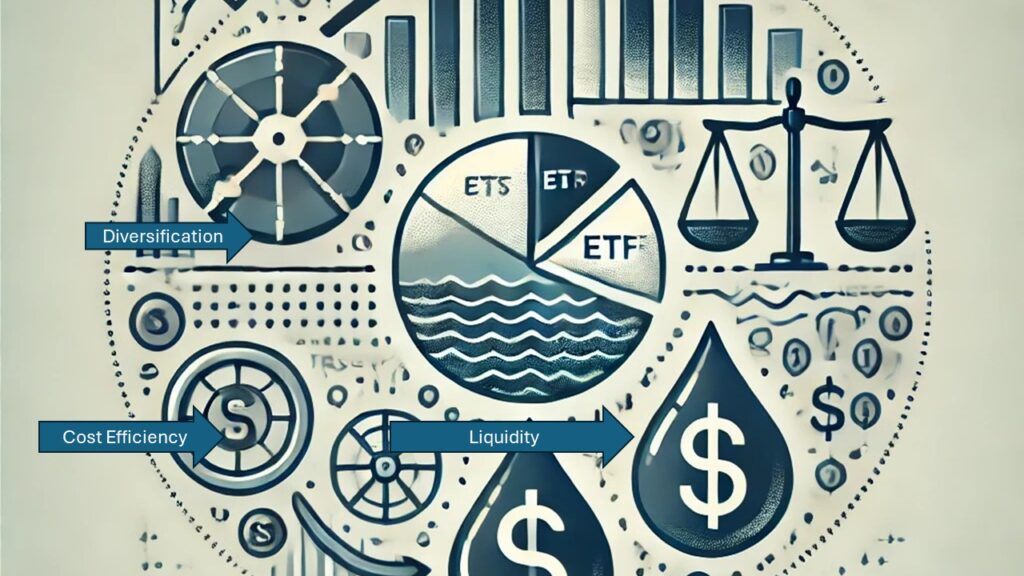- What are Exchange-Traded Funds (ETFs)?
- Historical Performance of ETF
- Benefits of Investing in Exchange-Traded Funds(ETFs)
- How to Choose the Right Exchange-Traded Funds (ETFs)
- How to Buy Exchange-Traded Funds (ETFs)
- Strategies for Investing in ETFs
- Monitoring and Managing Your ETF Investments
- Common Mistakes to Avoid When Investing in ETFs
- Practical tips for investing in ETFs
- Conclusion
Exchange-traded funds, or ETFs, are becoming a popular investment choice for many people. Whether you’re new to investing or looking to diversify your portfolio, ETFs offer a flexible and cost-effective way to grow your wealth. In this guide, we’ll walk you through everything you need to know about investing in ETFs, from understanding what they are to choosing the right ones for your financial goals.
What are Exchange-Traded Funds (ETFs)?
ETFs are investment funds that are traded on stock exchanges, much like individual stocks. Generally, they are designed to track the performance of a specific index, sector, commodity, or other assets. For example, an S&P 500 ETF aims to replicate the performance of the S&P 500 index. Therefore, this structure allows investors to gain exposure to a broad range of securities through a single investment.
Unlike mutual funds, which are only traded at the end of the trading day, ETFs can be bought and sold throughout the day, providing more flexibility. They also typically have lower fees compared to mutual funds, making them a more cost-effective option for many investors.
Historical Performance of ETF
ETFs, like the S&P 500 Vanguard ETF, follow the performance of many big companies. Over the last five years, this ETF grew a lot because the companies it follows did well. Investing in ETFs can be a good way to spread your money across many companies, which helps lower risk. Even though some ETFs can go up and down a lot, they usually give a good return over time, especially if you stick with them.

Practical Example Of Investing in ETF
Imagine a 14-year-old named Ria who gets some birthday money and decides to invest $100 in an ETF that tracks the S&P 500, like the one shown in the chart. Over five years, the value of her investment grows as the companies in the S&P 500 do well. By the time she’s 19, her investment could be worth around $191 if the ETF has grown by about 91% during that time. This example shows how investing in an ETF can help her savings grow over time.
Benefits of Investing in Exchange-Traded Funds(ETFs)
Investing in ETFs comes with several benefits:
- Diversification: ETFs allow you to spread your investment across a variety of assets, reducing the risk associated with investing in a single security. (Click Here To Know The Importance Of Diversification)
- Cost-Efficiency: ETFs often have lower expense ratios compared to mutual funds, meaning you keep more of your returns.
- Flexibility and Liquidity: Since ETFs are traded on stock exchanges, you can buy and sell them throughout the trading day at market prices, making them a flexible option for investors.

How to Choose the Right Exchange-Traded Funds (ETFs)
Choosing the right ETF depends on your investment goals and risk tolerance. Here’s how to get started:
- Identify Your Investment Goals: Are you looking for long-term growth, income, or capital preservation? Your goals will help you decide which type of ETF is right for you.
- Research ETF Options: Look into different ETFs that match your goals. Please pay attention to the underlying index, the ETF’s performance history, and its expense ratio.
- Understand the ETF’s Holdings: Make sure you understand what assets the ETF holds and how they align with your investment strategy. For example, a technology ETF will have different risk factors compared to a bond ETF.
Examples of different investor profiles using ETFs:
- Conservative Investor: A retiree named Raj wants stable returns with minimal risk. He invests in a bond ETF that tracks government bonds, providing regular income with low volatility.
- Growth-Oriented Investor: A young professional, Ananya, is willing to take on more risk for higher returns. She invests in a technology-focused ETF, capitalizing on the potential growth of tech companies.
- Balanced Investor: Alex, in his 30s, prefers a mix of growth and stability. He invests in a diversified ETF that includes a mix of stocks and bonds, balancing risk and potential returns.
These examples showcase how different investors can use ETFs to meet their specific financial goals.
How to Buy Exchange-Traded Funds (ETFs)
Once you’ve chosen an ETF, the next step is to buy it. Here’s how:
- Open a Brokerage Account: If you don’t already have a brokerage account, you’ll need to open one. Many brokers offer easy-to-use platforms with low fees.
- Place a Buy Order: Once your account is set up, you can place a buy order for the ETF. You can choose different types of orders, such as a market order (buy at the current price) or a limit order (buy only if the price falls below a certain level).
- Timing Your Purchase: Consider the timing of your purchase. It’s generally a good idea to avoid times of high market volatility and remember that the stock market is closed on weekends and holidays.
Strategies for Investing in ETFs
There are several strategies you can use when investing in ETFs:
- Long-Term Investing: Hold ETFs for a long period to benefit from market growth over time.
- Dollar-Cost Averaging: Invest a fixed amount regularly, regardless of market conditions, to reduce the impact of market volatility. (Click Here To Know More On Dollar Cost Averaging)
- Sector Rotation: Adjust your ETF holdings based on the performance of different sectors. For example, you might shift from technology ETFs to healthcare ETFs if you believe the latter will perform better.
Monitoring and Managing Your ETF Investments
After you’ve invested in ETFs, it’s important to keep an eye on your portfolio:
- Track Performance: Regularly review how your ETFs are performing and compare them against your investment goals.
- Rebalance Your Portfolio: Over time, some investments may grow faster than others, throwing your portfolio out of balance. Rebalancing involves buying and selling assets to restore your original investment mix.
- Stay Informed: Keep up with market trends and news that might affect your ETFs. This will help you make informed decisions about your investments.
Common Mistakes to Avoid When Investing in ETFs
Here are some common mistakes to avoid:
- Over-Trading: Trading too frequently can lead to high transaction costs and reduce returns.
- Ignoring Fees: While ETFs generally have low fees, they can add up over time. Make sure you understand all the costs associated with your investments.
- Lack of Diversification: Don’t put all your money into one type of ETF. Diversify across different asset classes to manage risk effectively.
Practical tips for investing in ETFs
- Start Small: Begin with a small investment to understand how ETFs work.
- Use Dollar-Cost Averaging: Invest a fixed amount regularly to mitigate market volatility.
- Reinvest Dividends: Use any dividends received to buy more ETF shares.
- Stay Informed: Regularly review the performance of your ETFs and the market.
- Diversify: Invest in a mix of different ETFs to spread risk.
These tips can help you make more informed decisions and optimize your investment strategy.
Conclusion
Investing in ETFs is a great way to build a diversified and cost-effective portfolio. By understanding what ETFs are, how to choose the right ones, and following smart investment strategies, you can make the most of this flexible investment option. Remember to monitor your investments regularly and stay informed to ensure you’re on track to meet your financial goals.
Ready to start investing in ETFs? Open a brokerage account today and begin building your portfolio!

